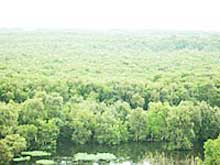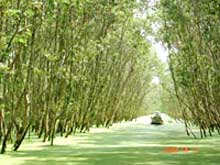The Tra Su forest, located in An Giang province, an inland area near the Cambodian border, is fast becoming an international destination for tourists, scientists and researchers who marvel at its beautiful landscape, mysterious atmosphere and diverse wildlife.

For the majority of tour organisers, Tra Su, unlike areas in neighbouring Dong Thap and Ca Mau provinces, is thankfully still off the tourism radar. That has kept it pristine and an ideal sanctuary for a vast array of wildlife.
Last year, the An Giang Province’s People’s Committee committed itself to a four-year, US$1.87 million project that will preserve the Tra Su Forest, which contains the richest biodiversity of any wetlands area in Viet Nam ’s Mekong Delta.
The aim is not only to protect ecological diversity but create jobs for the area’s poor, 60 per cent of whom are ethnic minority Khmer.
Thirty kilometres away from Chau Doc town, the lush, flat area includes an 845-ha cajeput forest, designated by the province’s Agriculture and Rural Development Department as a special-purpose eco-tourism preserve. The forest is surrounded by a 645ha buffer zone that contains waterways which protect the preserve from human incursion.
The preserve contains a 3,000sq.m. fishing area, a 2.500sq.m. bat swamp and a 3,200sq.m. bird sanctuary, all of which cater to the demands of different types of guests, according to Dinh Thi My Lan, tourism director for the Tra Su forest preserve.
Visiting the key sites on foot would take all day, but during the high water season of September, visitors would be able to travel by motorboat. A leisurely five-hour round-trip journey would take you to all the significant sites while enjoying the fragrant flowers of the cajeput tree and the magical sounds of birds and other animals.
Many residents are farmers, who were busily attending to their paddies and fruit orchards, but happy to stop for a chat with guests.
The colour of the waterways changed from one place to another, sometimes turquoise and at other times silver, purple or amber, due to the numerous species of water creatures.
During the high water season, the forest’s canals and streams are dense with clusters of water ferns, a particularly vivid sight when the setting sun imparts a golden glow on the emerald-green duckweed that blankets the water’s surface.

Lotus flowers and water lilies, cultivated by local farmers to supplement their incomes during the rainy season, cover much of the water.
"The forest is a habitat for 140 plant species, including 79 species of medicinal herbs, hundreds of different animals and more than 70 species of water birds," Lan says. Some are rare and on the verge of extinction, including the “co An Do†(Indian stork or Mycteria leucocephala) and the “co ran†(Dieng Dieng or Anhinga Melanogaster).
For a quiet break, tourists can take time to visit the Khmer weavers who make lovely silk and brocade or Xu Lady Pagoda, Thoai Ngoc Hau Temple and the Oc Eo Thoai Son historical site. The Tinh Bien border market and palmyra sugar and bee-keeping operations are also nearby.
When local authorities complete the eco-tourism project in 2010, more jobs in the services sector are expected, Lan says. The area will then boast new dykes, guesthouses, roads and an improved power and clean water system. "Authorities are calling for investment from local and foreign companies so we can begin construction on the facilities for the eco-tourism site, which will include different areas for research, tourism and preservation," Lan said.